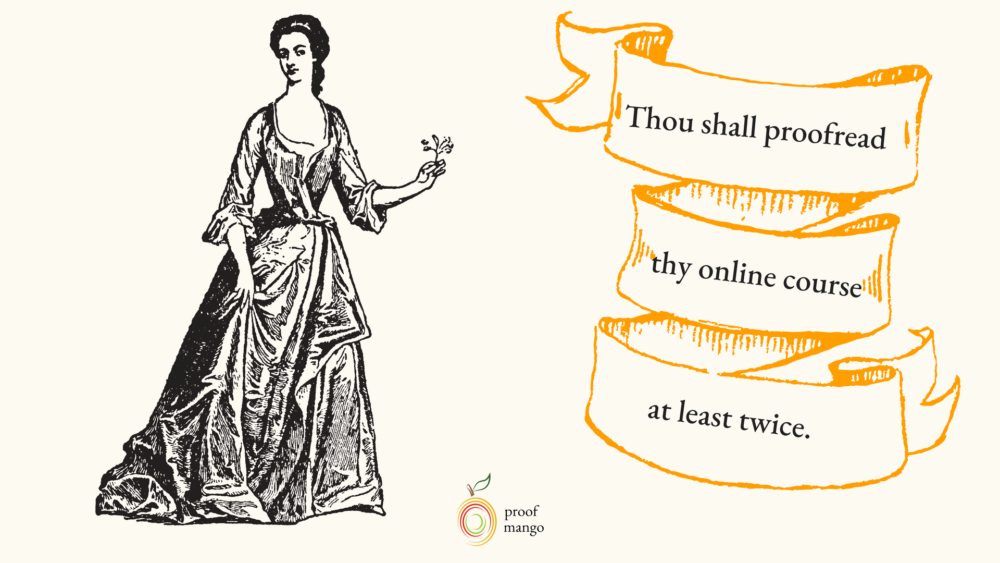
As online course creators, you have a lot going on.
You’re hustling day in and day out to put together a course that is effective and impactful for your students. And with so many moving parts, grammar and punctuation are usually the last things on your mind (if they’re on your mind at all).
And I get it. You shouldn’t have to focus on comma placement and subject-verb agreement when you’re in creation mode. But as an online teacher who wants to be taken seriously, grammar and punctuation must be tasks on your to-do list before you launch your course.
Because while little mistakes in your copy are easily forgiven by your students, it’s the larger grammar mistakes that cause the problems. And often, they can lead to questions about your effectiveness as an instructor.
For example: If you forget to add a period, that's pretty forgivable, and not the end of the world.
If you confuse “not” with “now” however, this could lead to a pretty confused student.
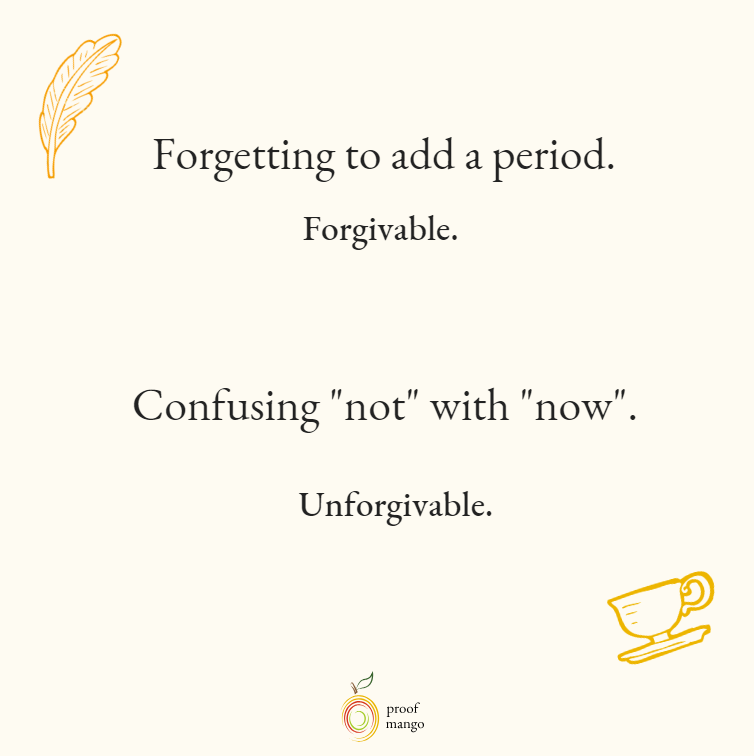
In this post, we’re going to discuss the role of grammar in your online course and why it’s so important. We’re also going to explain the negative effect it can have on your students when it's used incorrectly.
Lastly, we’re going to teach you a few methods for proofreading your course materials, and why you should do it at least twice before you launch.
Bonus: We’re also going to include some real-life examples of the types of comments potential students post when they catch grammar blunders in your course materials — they're pretty cringe-worthy!
Especially after you've put blood, sweat, and tears into your course.
Why is Good Grammar So Important in an Online Course?
Some people couldn’t care less about grammar, and that’s okay. A lot of people are of the belief that if the copy is understandable, a few grammatical errors are all right.
And it’s true, the world will not crumble if you use the wrong form of ‘your’.
But I like to compare good grammar in your copy to dressing for a speaking gig. If you were giving a presentation on something you were an expert on, would you show up in your comfy pants and a big t-shirt?
No way! You’d want to look good, and your course copy wants that too (as do your students).
There are four important reasons good grammar is vital if you’re creating an online course.
#1 Grammar Determines Your Students' Perception of You
When a student buys a course from you, they’ve said a resounding “yes” to trusting that you are the expert who can teach them what they’re itching to learn.
Like it or not, they’ve put you on a pedestal.
They are counting on you to guide them across the finish line for whatever they’re aspiring to be.
But your place on that pedestal falls down a few pegs when students catch errors in your course copy.
It’s not so much that they think you aren’t knowledgeable about the topic you’re teaching, but it can make them question your professionalism, as well as whether you deeply care about their understanding of your topic.
If you’re not passionate enough about their learning to make sure that your copy is written clearly and professionally, they might start to think twice about your intentions as an online teacher.
#2 Grammar Affects the Way You Communicate with Your Students
Students thrive on effective communication from their instructors. Nowhere is this more true than in an online classroom, where effective communication is the driver of student success.
In the online classroom, students are taking your course when they want, where they want. There are distractions and no hard deadlines for completing the assignments, or even for finishing the course.
The one thing you have to get right is communication.
It is key for your students to understand the principles you’re teaching. If you can’t effectively communicate what you’re teaching in your copy, your students won’t get as much out of your course as they could.
Not to mention, it hurts their ability to finish the course because what you're communicating to them isn't landing. You likely won't be getting any glowing testimonials from them, nor will they consider buying from you again.
#3 Bad Grammar Can Be a Distraction
Bad grammar can also be a major distraction for students who are struggling with the concepts you’re trying to teach. Especially if the concepts themselves are already hard to learn, like when you learn a coding language.
Not only will they have to read passages twice for misused or misspelled words, but if whole phrases are used incorrectly, it’s disruptive to their learning because they now need to take time to figure out what you’re trying to say.
This won’t bode well for them, or you. If something is frustrating for them to learn, and bad copy is distracting them, they’re more likely to leave a negative course review or send an angry email. (See how you can get rave online course reviews here.)
Make sure your grammar is good enough to where it's not distracting them from achieving their end goal.
#4 Bad Grammar is a Major Barrier to Purchase
Lastly, bad grammar is a barrier to purchase. If someone is considering your course, bad grammar or punctuation can confirm their decision not to buy.
It’s Basic Selling 101. People don’t approach your course sales page ready to buy unless you’re a next level marketer like Amy Porterfield (my personal favorite).
You need to convince them you're smart and worth buying from. Bad grammar isn’t doing you any favors.
I spoke to a course creator recently who posted his course sales page in a forum. There seemed to be just as many questions about his offer as there were about the way his sales page was written and designed.
Check out these examples from the thread below:
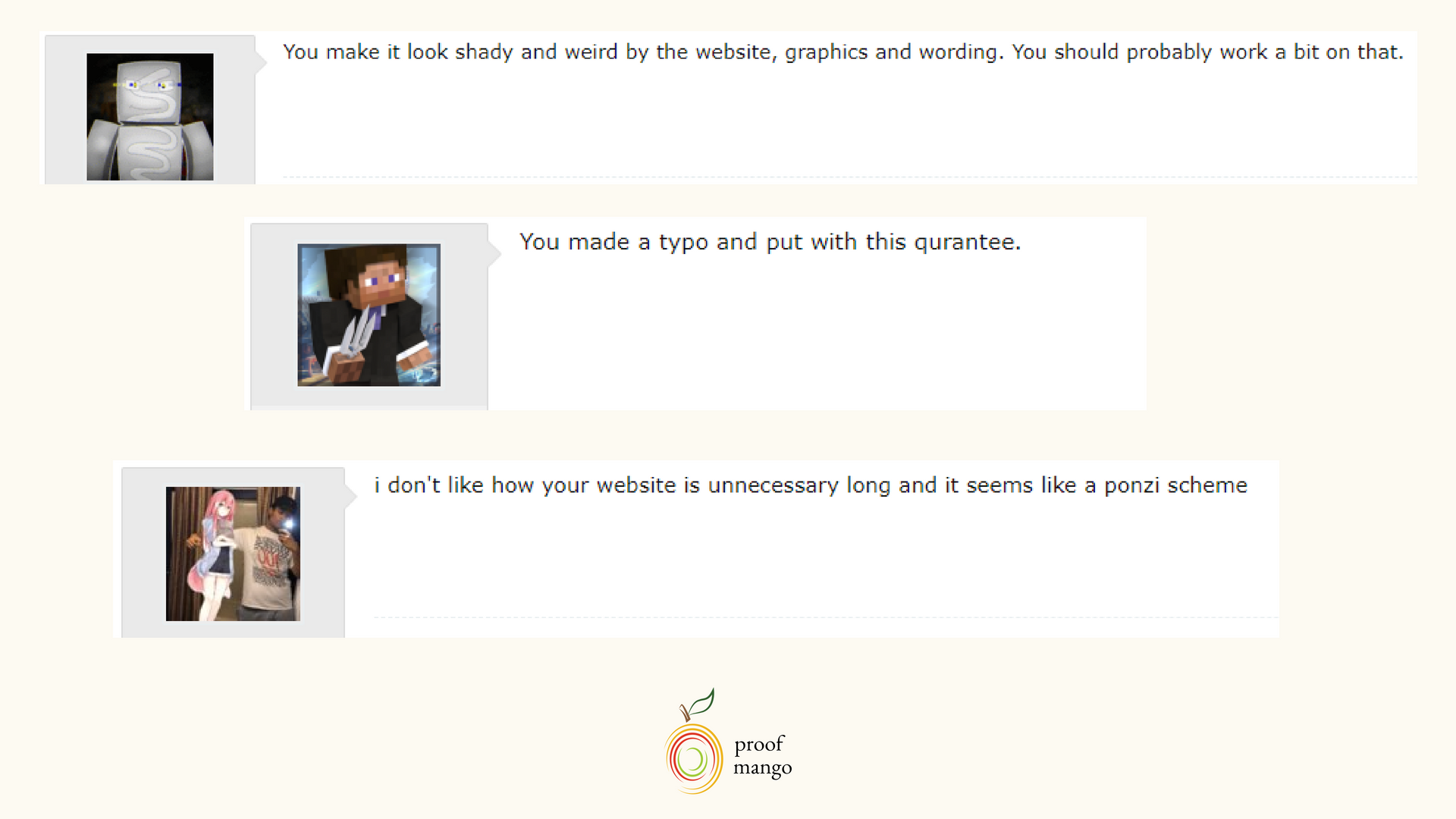
Many of these comments about his copy and design were barriers to purchase. Instead of focusing on the offer, many prospective students were distrustful of his page due to its copy errors and design.
Online students hold instructors to a high standard. They are especially cautious about where they spend their money and time, so you want to make sure your course materials are presented professionally, taking care to correct any wordy language or grammar slip-ups.
The Negative Effects of Bad Grammar on Your Students
Bad grammar is about more than just how your students perceive you. It hinders their ability to learn, it confuses the heck out of them, and it makes them feel like they’ve been duped in some way.
It’s hard enough to create, market, and sell your course, so you don’t want to lose them on grammar mistakes once they’re in.
Here are a few of the negative effects bad grammar can have on your students.
It’s Harder for Students to Learn
Every time your students have to stop and re-read a line in your course because of a grammar issue, it’s an extra step for them to learn the material.
Have you ever read something interesting, only to have your reading flow interrupted because the incorrect use of a word made you stop and scratch your head?
As an editor, this happens to me all the time, but that’s to be expected. Your students, on the other hand, won’t be expecting your copy to confuse or trip them up.
At best, they’ll feel frustrated, even unwilling to go back to your course because of the extra mental effort involved in parsing meaning from incorrect words or phrases, which can kill your course completion rates.
At worst, they’ll take a screenshot of the bad grammar and share it on social media (or leave a bad course review).
Neither situation is good. You want to make your copy as clear and error-free as possible when you’re teaching. And this should be reflected in your course slides and worksheets as well.
It’s Confusing as Heck
From start to finish, your course should have a clear direction. Your modules and lessons should follow a logical path, leading students to a transformation.
And the copy inside of those lessons is crucial to get right. Otherwise, you risk leading your students in an entirely different direction.
For example, I was once editing a course where the teacher shared an email template students could use to reach out to influencers. However, some of the sentences in the template were incomplete and appeared to have missing words.
This was really confusing because his students now had to guess what he was trying to say, which could have really impacted their outcome if they used the template he was suggesting.
If you’re sharing actionable information, it’s especially worth a proofread because your students will take what you share with them and run with it.
It Makes Them Feel Like They’ve Been Duped
Think about the times people have tried to dupe you into something.
You get an email from ‘Amazon.co.uk’ maybe, that says ‘click here to track your package’, but the subject line says:
“Your order fiNeWaY Heavy Duty has shipped!”
First red flag? Bad punctuation. This is the first tell-tale sign for anyone, that whoever this writer is, he or she can’t be trusted.
Like it or not, your students will subtly feel that you’ve tricked them in some way if they catch errors in your course.
They’ve trusted you to deliver the educational “goods”. By delivering slightly nicked and damaged goods, they may feel like they’ve made a mistake.
And this is clearly the last thing you want them to feel.
Methods for Proofreading Your Online Course
Now that the bad stuff is out of the way, let’s talk about what we can do to fix it!
If English isn’t your first language, you’re going to have a tough time giving your course modules and lessons a once-over for clear and error-free writing.
However, all is not lost!
There are brilliant tools out there that can help online course creators ensure they're finding and fixing as many errors as possible, even if they aren’t grammar savvy.
Use Grammarly to Check Your Grammar
One tool online course creators can use to proofread their materials is Grammarly. If you want to see if any common or, dare I say, unforgivable copy errors are in your course, Grammarly is a great one to use to give your content the once-over.
Use the Hemingway App to Check Your Style
Are your words too wordy? Too passive? Use the Hemingway App to make sure your sentences are highly readable and succinct.
You can paste your content into the app and it will highlight text that is too hard to read and let you know which phrases could be written better.
Read Your Copy Out Loud (Like a Robot)
This is a common practice for us here at Proof Mango. When we’re proofreading or editing course content, one of our techniques is reading the copy out loud.
Our eyes read text way too quickly to find small errors. The best way to make sure your content is clear and error-free is to read it out loud slowly, like a robot. Pronounce every syllable slowly to detect any errors that you might have missed reading it quietly.
You can also use Amazon Polly to read your content out loud if you don’t feel like doing it yourself. Sometimes when someone else reads your content, in this case, an actual robot, you’re more likely to hear errors that you might have otherwise missed.
Increase the Size of Your Text
This method is in no way fancy, but increasing the size of your text when proofreading (and double-spacing your copy) is great for helping you see the copy clearly when searching for errors.
When we get lessons in Google Docs, I typically will increase the text on the page to 150% so I can see every word, comma, or space up close.
Launching Your Course Without Proofreading (Twice)
It’s only human for us to make errors. Nobody is perfect when it comes to creating pristine content.
But if you’re creating an online course, just like if you were publishing a book, your content is expected to be more than pristine — it’s expected to be perfect.
If people are paying you for an info product, or some kind of online training program, and they receive subpar work, it will result in either a refund, a chargeback, or a bad review.
And who can afford that?
You want to make sure you’re proofreading your online course materials not once, but twice. As a seasoned copy editor and proofreader, I can assure you that you won’t catch every error the first time around. You just won’t.
Read your copy thoroughly at least twice before publishing it, using some of the methods and tools we mentioned above. There will still likely be something you missed, but the obvious (and unforgivable) errors will likely be found and fixed.
BONUS: Real Grammar Blunders Caught by Online Students
To wrap up this post, I wanted to share with you a few grammar blunders caught by students who either bought or were considering a particular online course.
I don't want these to happen to you, especially in live forums where anyone can view them.
My hope is that you learn from the mistakes of these course authors, so your course can be as beneficial for your students as possible!
#1 Right Spelling, Wrong Meaning (FTW)
I love it when I see words that are actually spelled correctly, but used incorrectly. This happens so often, which is why it's number one here. It reminds me that Grammarly can only go so far (even though I love and use it!).
Below is a comment made by a student who found two of these kinds of errors and pointed them out in the comments section of a webinar page. Both of the words the student caught were technically spelled correctly, but the meaning was thrown off because of accidental incorrect usage.

#2 Missing Phrases in CTAs
Call-to-actions are probably the most important pieces of text on your sales and landing pages. They are the only buttons you want people to click on the entire page. They should be as clear and easy to read as possible.
Below is a comment from a Facebook user on a course creator's sales page. The user kindly pointed out that the text in the course creator's CTA was missing the word “in”.
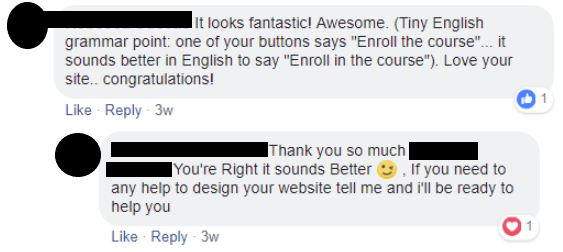
#3 The Classic “Your” vs. “You're” Mix-up
There will always be students who notice your faults. In fact, I think that's pretty true about people and life in general!
In the case below, a student reached out to a course creator regarding one of his programs. She said grammar was ‘her thing' and felt compelled to reach out.
You'd be doing yourself a service by getting spelling/grammar errors under control, so you don't get overrun with the same messages about content errors. We get enough email as it is, am I right?
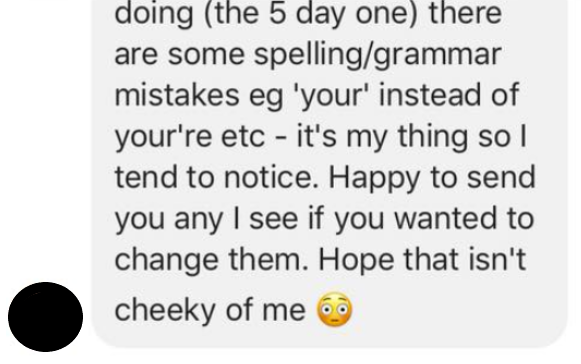
Summary
There's a lot of conflicting arguments out there about how important grammar really is as it relates to how people perceive you. And as busy online course creators, I understand that it's not usually your top priority when you're busy trying to market and sell your courses.
However, I'm of the belief that there's never a downside to good grammar.
If you can take the time to make sure your modules and lessons are in order, why not go the extra mile to make sure your words are in their best order as well?
Here's a rough summary of this post, for the skimmers and scrollers:
- Grammar has the potential to determine your students' perception of you. If it's not right, people may question how much you actually care about their success.
- If you can't communicate correctly with your students, you may be hindering their learning.
- Bad grammar is a distraction and a barrier to purchase of your course. Don't give them any reason to pause!
- Proofread your course using Grammarly, the Hemingway App, and/or by reading it out loud slowly like a robot. This will help you catch at least the majority of your errors!
If you're already proofreading your course materials, what methods are you using? Are you hiring someone, or are you going it alone with tools like Grammarly? Also, if you're not proofreading your course materials, do you think you'll start now? Why or why not?
Let me know in the comments, I'd love to hear your thoughts!




